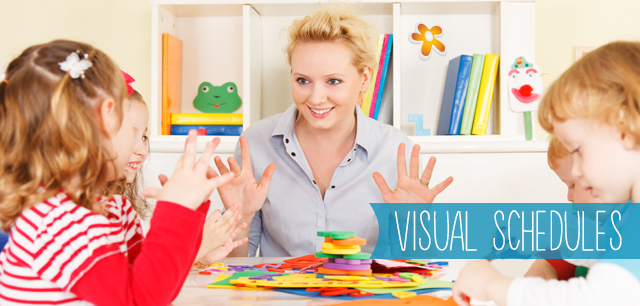Visual Schedules II
In Visual Schedules Part 1, we talked about the purpose behind Visual Schedules. In Part 2, we’ll consider a few of the various ways visual schedules can be used at home and in the classroom. Visual schedules have solid support from research and have been shown to be highly adaptable, inexpensive, and time efficient for both parents and teachers. With iPhones and the internet, it’s become even easier to take or find photographs to make the visual support more realistic (should your child need an exact photo to follow the schedule successfully). Some children may only need written supports.
Daily Schedule
This is the schedule usually thought of when discussing Visual Schedules. It’s a pictorial representation of a child’s day, beginning with the place where the schedule starts. So, if you were making a daily schedule for home, you might begin with a picture representing ‘getting out of bed’, but if you were creating a daily schedule for school, you might begin with ‘putting backpack in cubby’.
The daily schedule is a broad view of the child’s day by, usually, larger transitions. Some children have difficulty transitioning from one activity to the next, and this is a simple way to help them manage their anxiety about transitions and develop more independence in the process. It also gives them visual supports to keep them on task.
Here is an example of a great daily schedule:
Notice on this example how the schedule is represented in a horizontal way. This reads ‘across the page’ like a book. For some children, this orientation of the schedule will work best, for others a vertical schedule might be better. It’s really dependent of the child’s individual needs and what works best for the environment in which the schedule will be displayed.
Routine Schedule – A routine schedule is shorter than a daily schedule and only focuses on one routine for the child. This one is particularly helpful at home during morning routine or bedtime routine. In the example provided, you can see how the creator of this schedule incorporated the child’s special interest of trains, to provide extra motivation and structure to the schedule. Again, besides providing predictability and structure, it builds more skills toward independence.
Activity Schedule – An activity schedule is a very specific visual schedule to support the completion of a certain activity. It is used to help a child see the sequence and steps of an activity. Organizing and ordering information is paramount in so many language activities, including reading comprehension, conversations, and categorizing. Visually presenting the task, step-by-step, breaks the information down so the child ‘sees’ the process as well as the outcome. Using activity schedules for craft or snack/recipe creations are great ways to show part-to-whole relationships and allows for the child to be involved in the process as well. Here is an example of an activity schedule for making simple gingerbread cookies from a Gingerbread Man theme.
Skill Schedule – Along the same lines as the ‘activity schedule’, the skill schedule takes a ‘process’ and breaks it down into digestible parts with visual prompts. This type of schedule is particularly useful for skills such as potty training or dressing in the morning, even brushing teeth or other hygiene related topics.
Visual schedules can be made with pictures or words. They can be on large strips or small ones. They can be posted at the front of the class, or taped inside the front cover of your child’s textbook. Visual schedules can be displayed on paper, dry-erase boards, chalk boards, iPads/phones, or computers, as well as many other creative places. And despite what you might think, your child can use them (and may still need them) up through adulthood. Adolescents continue to benefit from written schedules inside their texts to help with organization and decreased frustration.
With visual learners, when we use pictures to assist in communication, there is a better chance for faster processing and greater skill development.
For more information on Visual Schedules, please see the links below.
LessonPix.com - This site has a lot of helpful examples of schedules and various ways of displaying them for children.
Pinterest also has all sorts of wonderful examples of Visual Schedules in various forms. www.pinterest.com
At Carolina Pediatric Therapy our expertise and experience benefit not only the child being treated, but their family as well. We strive for excellence in all forms of pediatric therapy and family support. If you have concerns or questions about your child or the services we offer, call us today at 828.670.8056.
Visual Schedules – Part 2
Pepper Basham, MS, CCC-SLP
Want to know how a Therapist can Help?
Call (828) 398 0043 or click on the schedule button.



